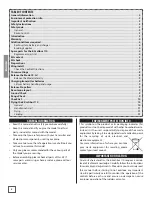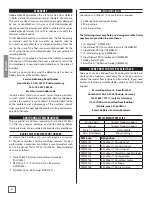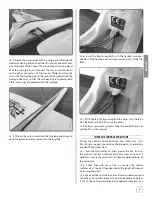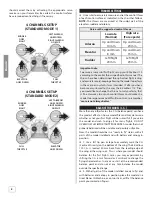
11
HAND LAUNCH START
Before launching, be sure that the battery is fully charged
and all control surfaces are working properly. Any negligence
on these checks can result in a crash and damages to the
model.
Always lauch the model directly to the wind. When you are
ready, set throttle at 75% and launch with a good impulse
directly to the wind. The acceleration is quick. The model climb
with a 30-40° angle. At full throttle, with a small elevator input,
the E-Xcalibur 110 can climb vertically. Have in mind that the
pilot should keep concentrated, because the model may be
very high in a very short time.
FLYING
For reassurance and to keep an eye on other traffic, it is a
good idea to have an assistant on the flight line with you. If
you choose to fly with motor active, tell him to remind you to
throttle back once the plane gets to a comfortable altitude.
While a lot of throttle is usually desirable for takeoff, the
E-Xcalibur fly more smoothly at reduced speeds and only
need a little power to maintain altitude.
Take it easy with the E-Xcalibur 110 for the first few flights,
gradually getting acquainted with it as you gain confidence.
Adjust the trims to maintain straight flight and a smooth
gliding path. After flying around for a while, and while still at a
safe altitude, practice slow flight and execute practice landing
approaches. Makes also few low fast passes, followed by full
throttle climbs, and then, dive with motor off. Propeller folded,
the model reaches his maximum speed.
Practice different maneuvers and ask to your assistant to notice
the changes to make to the settings (C.G., Throws, expo...) to
remember them after the flight. Mind your battery level, but
use this first flight to become familiar with your model before
landing.
LANDING
Prepare landing by a downwind leg at an 20-30 m altitude.
With motor shutted down and retracted, set landing gear
down. Allow the nose of the model to pitch downward slightly
to gradually bleed off altitude. Continue to lose altitude, but
maintain airspeed by keeping the nose down as you turn
onto the crosswind leg. If you are too long, or if the approach
is not correct, don't wait to be very low, restart the motor
and and climb out to make another attempt. When you’re
ready to make your landing flare and the model is a foot or
so off the deck, smoothly increase up elevator until it gently
touches down. Once the model is on the runway and has lost
flying speed, hold up elevator to place the tail on the ground.
Using ailerons, keep wings level as long as you can. Note :
This model lose few altitude with motor off, so, you may need
some attemps before your first successfull approach, so, keep
energy into your battery to be able to make several attemps.
One final note about flying your model.
Have a goal or
flight plan in mind for every flight. This can be learning a new
maneuver(s), improving a maneuver(s) you already know, or
learning how the model behaves in certain conditions (such
as on high or low rates). This is not necessarily to improve your
skills (though it is never a bad idea!), but more importantly
so you do not surprise yourself by impulsively attempting a
maneuver and suddenly finding that you’ve run out of time,
altitude or airspeed. Every maneuver should be deliberate,
not impulsive. For example, if you’re going to do a loop,
check your altitude, mind the wind direction (anticipating
rudder corrections that will be required to maintain heading),
remember to throttle back at the top, and make certain you
are on the desired rates (high/low rates). A flight plan greatly
reduces the chances of crashing your model just because of
poor planning and impulsive moves. Remember to think.
Have a ball!
But always stay in control and fly in
a safe manner.
GOOD LUCK AND
GREAT FLYING!
ENGLISH
Summary of Contents for TZNA1100
Page 12: ...Distributed by www hobbico de...






























